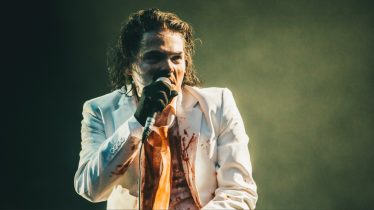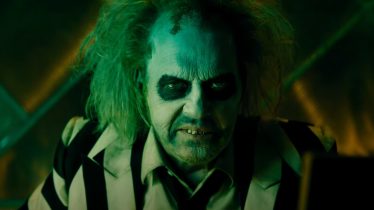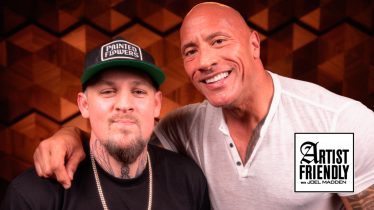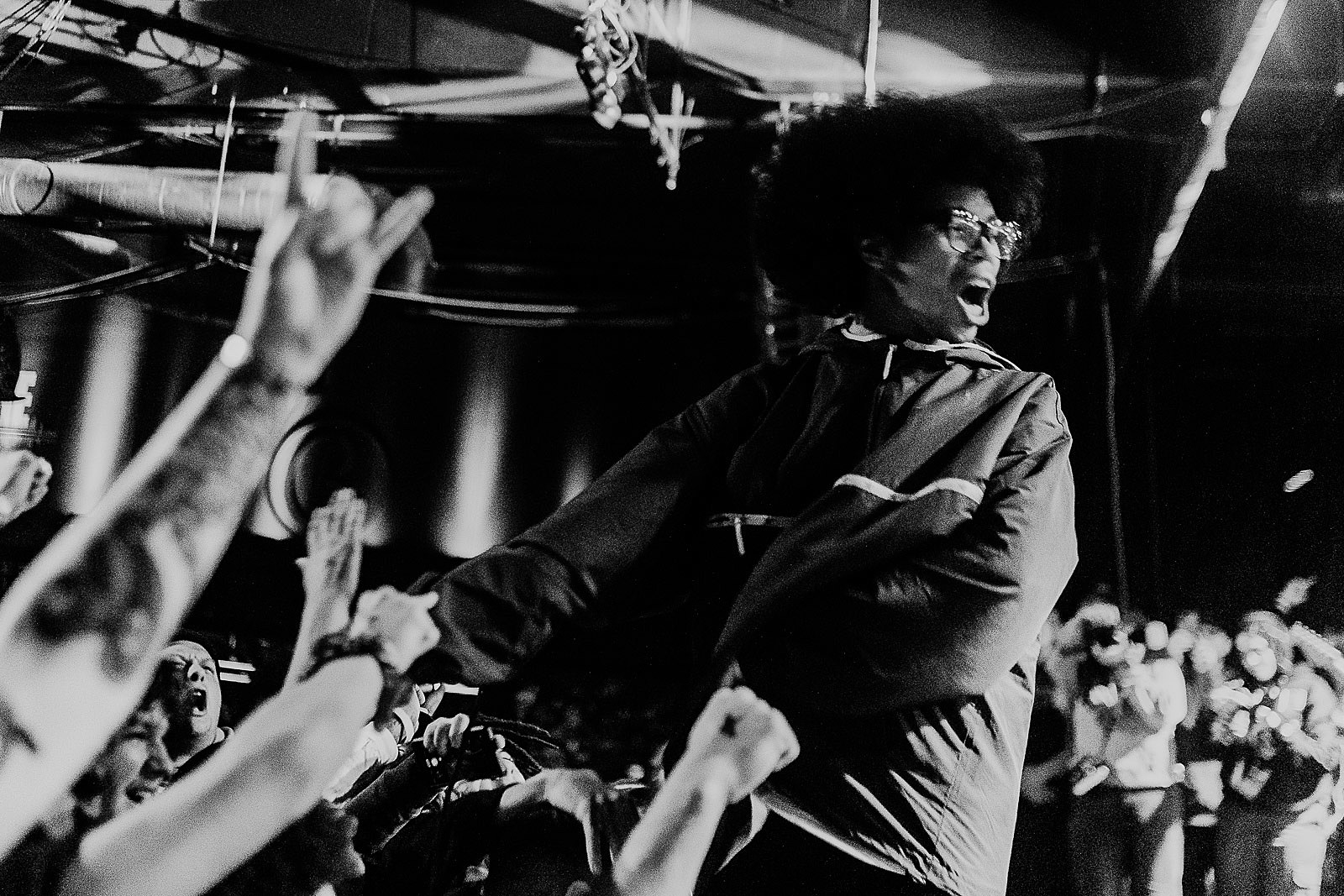
The rise of Australian collective Haiku Hands
Haiku Hands are altogether unexpected. There is the music, a Frankenstein's monster of genres and philosophies that is at once ferocious and playful. Alternative dance music, if brave enough to stick a label on it. The Beastie Boys if they were a fiery girl group from Australia, if I had the audacity to compare.
Then there are the members themselves: a masked collective, sometimes three or four, sometimes more. They may show up with dancers or DJs onstage. They’ve performed in sumo suits, and they’ve performed while nine months pregnant. All in all, anyone who has seen or heard Haiku Hands knows they are unlike anything else.
Read more: Balming Tiger is the 11-member collective with an alternative vision of K-pop
That’s exactly how they want it. Catching up with sisters Mie and Claire Nakazawa, two of the three core members, the conversation is dominated by the phrase “push boundaries," accompanied by an all-you-can-eat buffet of synonyms. Although they are strikingly humble, it’s a phrase that they have earned.
It didn’t take long for people to notice the bold artistry coming from Haiku Hands. Their first-ever show was a performance at Falls Festival in 2017, and since then, they’ve filled opening slots for Tame Impala, Cupcakke, Flight Facilities, SOFI TUKKER, and Bloc Party, as well as sold out their own headlining tours in Australia.

In Australia, they can be found playing to packed, exhilarated crowds. When I saw the three core creative forces behind Haiku Hands — Claire Nakazawa, Mie Nakazawa, and Beatrice Lewis — in Toronto, yet to break the Canadian market, they brought the same energy to a tiny, 150-capacity venue. They made it feel huge. The night ended with everyone sweaty and euphoric. My videos were of a shaky, blurry, irredeemable quality. Four minutes of footage display the shadowy insides of my pocket, soundtracked by pulsing bass, and shouting, riotous energy. I could not have captured a better representation of their live shows. Forget your phone. Dance, get chaotic. When it comes to a Haiku Hands show, you just have to be there.
Amid this take-no-prisoners approach to creating a good time, it can be all too easy to remain oblivious to the intelligence behind the beats. Crowds sing and dance along, all the while unaware that Haiku Hands’ lyrics are subversive, witty, philosophical explorations of technology, social norms, and relationships. Take the latest single from their upcoming sophomore album, Pleasure Beast (out Dec. 1), for one. “Feels So Good” is a Fatboy Slim and Gorillaz-infused track that could animate the most mundane of moments and happens to be “about speaking your truth into a world that would often much prefer you to stay quiet, polite, in line and obedient. It can be speaking loud political truths or quiet needs and wants to the people closest to you,” Lewis says.
She continues, “This song is a dedication to those moments in your life when you can be brave enough to find your voice and let it out.” Then look to their genre-defying, eponymous debut album. “Manbitch” “highlights linguistics and gender stereotypes,” while “Mechanical Animal” is about a “meeting place between technology and our natural animal instincts.” “Fashion Model Art,” a collaboration with dance-duo SOFI TUKKER, playfully pokes fun at the ridiculousness of the art/fashion world. Even their name is thoughtful — “Haiku” refers to words, poetry, finding the essence of an idea in the purest way possible, and “Hands” acknowledges the collaborative nature of the project.
Their delivery of these themes is often dadaist in nature — “I'm going to tear up the lexicon with a hexagon and my sexy thong on,” from “Not About You” is a standout example of their shocking absurdity. Their intentional juxtaposition of the political and the absurd, grounded in the act of creation and the audience experience, creates a liberating and multi-dimensional ethos. Haiku Hands can be an experience, or an idea, or both. The best part is that you can enjoy yourself immensely no matter how deep you go — feel free to take one great show, a favorite band, or a new approach to life.

At first appraisal, the offstage personalities of Claire and Mie are almost entirely incongruent with their stage presence. The sisters are quiet, reserved, and pensive. It’s not a detached cool of someone used to basking in praise onstage. It’s a humble, introverted demeanor that is more confident behind a mask or pointing the praise at someone else. I would stock it up to the time difference — “I just woke up,” Mie smiles upon picking up my video call, and Claire, lost in the jungle of WhatsApp group chats, takes another few minutes to find us — if other video interviews didn’t verify this first impression.
Quiet, meandering answers seem to discover themselves partway through. But through the lackadaisical delivery comes unceasing stories brimming with extraordinary passion and zealous devotion to art.
“As a little kid, I was pretty obsessed with listening to the radio, and I would make my own radio station,” Mie says, the younger of the two siblings by two-and-a-half years. “I had two tape players, and I would record the radio onto them. Once I had all the songs I wanted, I would place them next to each other how I wanted. I also recorded little bits of my voice in between…” Here she pauses, gazing into the distance, and says, as though it’s a realization: “Yeah, I was actually really obsessed with music when I was younger.”
Their family is credited with sparking a passion for art, which would later flame into Haiku Hands. “Both of our parents were yoga teachers, so there were quite a few alternative people around,” Mie explains. “Our step-grandfather was in the Sydney Symphony. He was a violin player. Our dad did Japanese Butoh and dance and wrote poetry.” Their mom also bestowed them with a diverse taste in music; the sounds of their childhood included Tracy Chapman, Bob Dylan, OutKast, and Naughty by Nature.
Plus, she took them to piano lessons, drumming circles, and whatever music happened to stop by their hometown of Australia’s Blue Mountains. “Whatever music came there, our mum would take us along, and we would fall asleep on the stairs with heaps of jackets over us,” Mie says. Contributing to their range of influences, Claire explains that in “Blue Mountains, there's quite a strong hip-hop culture. So a lot of the kids up here are really into all the hip-hop that was coming out during that era.”
To no one’s surprise, a 14-year-old Claire had a spiritual experience at her first concert, none other than Beastie Boys. “It was at the Forum Pavilion, which is this 5,000-capacity venue, and it was this whole other world than your average life. All these people come together to share something that they all love. It's almost like a church, a different form of a congregation, where you just enjoy something together with heaps of people.”
But when the Nakazawa sisters first shared a stage, it wasn’t music. It was visual art: live, interactive, freestyle art, in front of audiences at bars and folk festivals around Australia. “For about five years before Haiku Hands, we had been a part of a crew called Sketch the Rhyme, which was a multimedia rap music/art show,” Claire explains. “We were the visual artists in that, so we'd stand onstage and draw live. There'd be music playing, and we would be onstage painting.”

Visual art is an important outlet for both sisters, so much so that they both went to art school, and their first official collaboration was an art exhibition that they put on together. Mie describes collaborating as like-minded siblings as both liberating and necessary. “I feel like there were not many women, like close friends, doing what we were doing, so involved with art, so involved in music. So I think we look to each other to have that support. It's so much easier to have someone else to back you because you're coming up with these odd ideas,” she laughs. “Me and Claire were quite similar in our ambition to challenge the norm and push the boundaries on what we always see and hear. It's nice to have that collaboration with someone else who has a similar vision to you.”
That bold vision is thoroughly shared by the third main member of Haiku Hands, Lewis, who Claire likens to being “very much like a bull. She goes forth and helps make things happen.” Lewis also boasts an impressive musical resume as a singer, songwriter, and producer — she is an alumnus of the Red Bull Music Academy, has a catalog of solo music, and is a member of the critically acclaimed band Kardajala Kirridarra, which blend contemporary electronic music with traditional indigenous themes. “Our immediate connection was finding another woman who was interested in a similar thing,” Claire reminisces. “We were both very motivated and hardworking and enjoyed working. I guess you could say ambitious, but we just really, really wanted to do it basically.”
For this highly collaborative group — they used to go as far as calling Haiku Hands more of an art collective — they seek the same energy in those they work with. They choose collaborators who "enjoy humor,” “push boundaries that they haven't pushed before and don’t want to do something that’s already been done,” and “have a strong feeling themselves.”
The idea of Haiku Hands as an art collective started because they wanted to acknowledge the contributions of their many collaborators, “especially early on when there wasn't much money or anything involved. Everyone was doing it for the love and for the joy of creating, collaborating, and making something cool.” That desire to create an open and welcoming community remains: “We love it when someone comes and is part of the project, even if it's temporarily, but they can feel like they're part of that. So that's the idea behind it being an open kind of project,” Claire says.
But with the amount of dedication and energy that Mie, Claire, and Lewis are now putting into a more successful — therefore more demanding — version of the project, they feel comfortable claiming their spots at the forefront. “Over time, I think we have become more of a group rather than a collective because I guess the workload that we do is a lot,” Claire explains. “I'm also excited that we're doing a bit more ourselves on this album [Pleasure Beast].
"We're outsourcing a little bit less than we did in the beginning. We've been recording ourselves a bit and having sessions where it's just the three of us. So I think it'll bring a bit of a different sound. We'll still have members join us and fluidity with the group in that way because I feel like Haiku Hands is its own energy, as opposed to specifically about us as individuals. I think I want to keep that element to it.”
Haiku Hands are continually surprising and dichotomous: philosophy and fun; their riotous stage personas and the humble, unhurried sisters I speak to; open to the world and yet so intrinsically made up of three devoted artists. However, one thing is straightforward and as clear as day: Haiku Hands are excited about the future. With four bold singles out (“Nunchuka,” “Ma Rula,” “Feels So Good,” and the newly released “Cool For You”) and their sophomore album, Pleasure Beast, imminent, there’s a lot to look forward to and no reason to slow down. At the end of our conversation, Claire gives some amazing advice that both epitomizes Haiku Hands and has a practical application for listening to all of their music: “Be in a space where you can play it really loudly. And that you can dance [in]. Because we like jumping around to it.”










